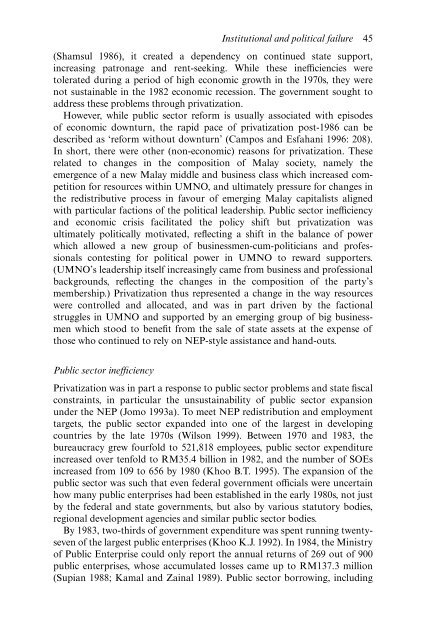PRIVATIZATION Privatization in Malaysia, Regulation, rent-seeking and policy failure
PRIVATIZATION Privatization in Malaysia, Regulation, rent-seeking and policy failure
PRIVATIZATION Privatization in Malaysia, Regulation, rent-seeking and policy failure
Create successful ePaper yourself
Turn your PDF publications into a flip-book with our unique Google optimized e-Paper software.
Institutional <strong>and</strong> political <strong>failure</strong> 45(Shamsul 1986), it created a dependency on cont<strong>in</strong>ued state support,<strong>in</strong>creas<strong>in</strong>g patronage <strong>and</strong> <strong>rent</strong>-seek<strong>in</strong>g. While these <strong>in</strong>efficiencies weretolerated dur<strong>in</strong>g a period of high economic growth <strong>in</strong> the 1970s, they werenot susta<strong>in</strong>able <strong>in</strong> the 1982 economic recession. The government sought toaddress these problems through privatization.However, while public sector reform is usually associated with episodesof economic downturn, the rapid pace of privatization post-1986 can bedescribed as ‘reform without downturn’ (Campos <strong>and</strong> Esfahani 1996: 208).In short, there were other (non-economic) reasons for privatization. Theserelated to changes <strong>in</strong> the composition of Malay society, namely theemergence of a new Malay middle <strong>and</strong> bus<strong>in</strong>ess class which <strong>in</strong>creased competitionfor resources with<strong>in</strong> UMNO, <strong>and</strong> ultimately pressure for changes <strong>in</strong>the redistributive process <strong>in</strong> favour of emerg<strong>in</strong>g Malay capitalists alignedwith particular factions of the political leadership. Public sector <strong>in</strong>efficiency<strong>and</strong> economic crisis facilitated the <strong>policy</strong> shift but privatization wasultimately politically motivated, reflect<strong>in</strong>g a shift <strong>in</strong> the balance of powerwhich allowed a new group of bus<strong>in</strong>essmen-cum-politicians <strong>and</strong> professionalscontest<strong>in</strong>g for political power <strong>in</strong> UMNO to reward supporters.(UMNO’s leadership itself <strong>in</strong>creas<strong>in</strong>gly came from bus<strong>in</strong>ess <strong>and</strong> professionalbackgrounds, reflect<strong>in</strong>g the changes <strong>in</strong> the composition of the party’smembership.) <strong>Privatization</strong> thus represented a change <strong>in</strong> the way resourceswere controlled <strong>and</strong> allocated, <strong>and</strong> was <strong>in</strong> part driven by the factionalstruggles <strong>in</strong> UMNO <strong>and</strong> supported by an emerg<strong>in</strong>g group of big bus<strong>in</strong>essmenwhich stood to benefit from the sale of state assets at the expense ofthose who cont<strong>in</strong>ued to rely on NEP-style assistance <strong>and</strong> h<strong>and</strong>-outs.Public sector <strong>in</strong>efficiency<strong>Privatization</strong> was <strong>in</strong> part a response to public sector problems <strong>and</strong> state fiscalconstra<strong>in</strong>ts, <strong>in</strong> particular the unsusta<strong>in</strong>ability of public sector expansionunder the NEP (Jomo 1993a). To meet NEP redistribution <strong>and</strong> employmenttargets, the public sector exp<strong>and</strong>ed <strong>in</strong>to one of the largest <strong>in</strong> develop<strong>in</strong>gcountries by the late 1970s (Wilson 1999). Between 1970 <strong>and</strong> 1983, thebureaucracy grew fourfold to 521,818 employees, public sector expenditure<strong>in</strong>creased over tenfold to RM35.4 billion <strong>in</strong> 1982, <strong>and</strong> the number of SOEs<strong>in</strong>creased from 109 to 656 by 1980 (Khoo B.T. 1995). The expansion of thepublic sector was such that even federal government officials were uncerta<strong>in</strong>how many public enterprises had been established <strong>in</strong> the early 1980s, not justby the federal <strong>and</strong> state governments, but also by various statutory bodies,regional development agencies <strong>and</strong> similar public sector bodies.By 1983, two-thirds of government expenditure was spent runn<strong>in</strong>g twentysevenof the largest public enterprises (Khoo K.J. 1992). In 1984, the M<strong>in</strong>istryof Public Enterprise could only report the annual returns of 269 out of 900public enterprises, whose accumulated losses came up to RM137.3 million(Supian 1988; Kamal <strong>and</strong> Za<strong>in</strong>al 1989). Public sector borrow<strong>in</strong>g, <strong>in</strong>clud<strong>in</strong>g


